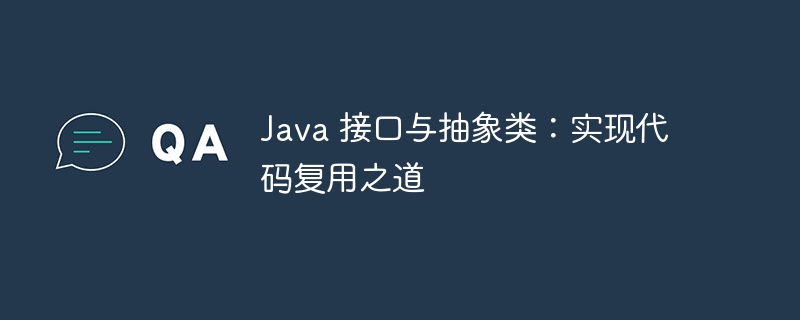

"Java Interfaces and Abstract Classes: How to Implement Code Reuse" is an article carefully written by PHP editor Xiaoxin. From the perspective of Java programming, this article deeply discusses the importance and application of interfaces and abstract classes in code reuse. Through the analysis and comparison of example codes, it helps readers better understand how to use interfaces and abstract classes to achieve code reuse and improve code reusability and maintainability. This article is a rare learning material for readers who want to learn Java programming systematically.
Abstract class
Choose interface or abstract class
Choosing an interface or an abstract class depends on the specific scenario:
Code reuse
Through interfaces and abstract classes, we can achieve code reuse, reduce redundancy and improve flexibility:
Polymorphism
Interfaces and abstract classes also facilitate polymorphism, the ability to handle different types of objects in a uniform way:
Example
Interface example:
public interface Shape {
double getArea();
double getPerimeter();
}Abstract class example:
public abstract class Animal {
protected String name;
public abstract void speak();
public void eat() {
System.out.println("Animal is eating.");
}
}Code reuse example:
ClassesCircle and Square implement getArea() and getPerimeter() by implementing the Shape interface method, thereby reusing the code for calculating the area and perimeter of a shape.
public class Circle implements Shape {
private double radius;
@Override
public double getArea() {
return Math.PI * radius * radius;
}
@Override
public double getPerimeter() {
return 2 * Math.PI * radius;
}
}
public class Square implements Shape {
private double side;
@Override
public double getArea() {
return side * side;
}
@Override
public double getPerimeter() {
return 4 * side;
}
}Polymorphism example:
We can use Shape type variables to store Circle and Square objects and call their methods in a polymorphic manner.
Shape shape1 = new Circle(5); Shape shape2 = new Square(10); System.out.println(shape1.getArea()); // 78.53981633974483 System.out.println(shape2.getPerimeter()); // 40.0
By leveraging interfaces and abstract classes, Javaprogrammers can achieve code reuse and polymorphism, thereby writing more flexible and maintainable code.
The above is the detailed content of Java interfaces and abstract classes: the way to achieve code reuse. For more information, please follow other related articles on the PHP Chinese website!
 How to change phpmyadmin to Chinese
How to change phpmyadmin to Chinese
 What are the Python artificial intelligence frameworks?
What are the Python artificial intelligence frameworks?
 python configure environment variables
python configure environment variables
 Which platform is better for virtual currency trading?
Which platform is better for virtual currency trading?
 Windows 10 startup password setting tutorial
Windows 10 startup password setting tutorial
 Detailed explanation of netsh command usage
Detailed explanation of netsh command usage
 What are the servers that are exempt from registration?
What are the servers that are exempt from registration?
 How to remove the border of the text box
How to remove the border of the text box




